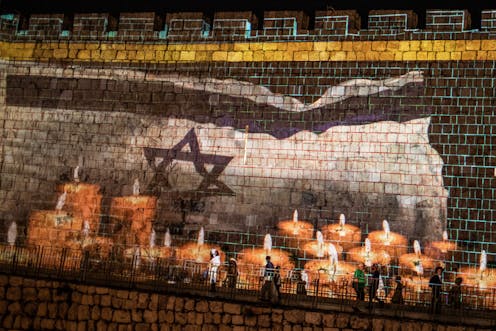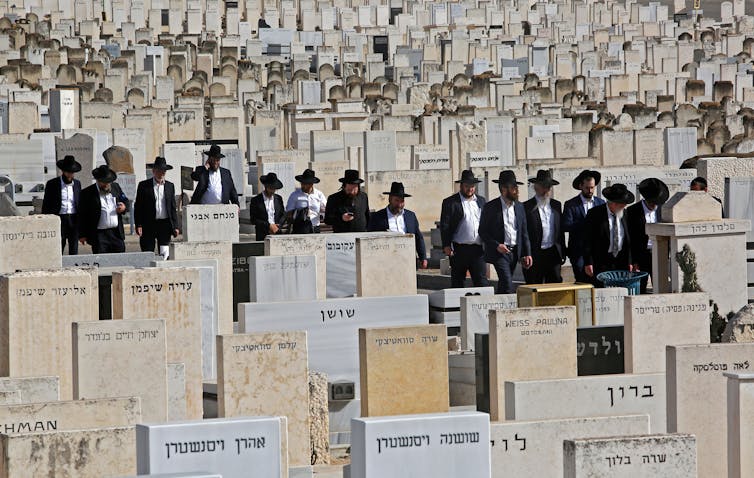Lag BaOmer pilgrimage brings Orthodox Jews closer to eternity – I experienced this spiritual bonding
The Lag BaOmer pilgrimage, in which 45 people died recently, takes place each year to what is believed to be the gravesite of the second-century Talmudic sage Rabbi Shimon Bar Yochai.

The annual Lag BaOmer pilgrimage to Mount Meron in Israel attracts as many as half a million visitors every year. Because of COVID-19, this year’s event was less crowded, but even so, over 100,000 people were packed into a space with a capacity for perhaps 15,000. This overcrowding reportedly contributed to the recent tragedy, in which at least 45 people, mostly ultra-Orthodox Jews known as “Haredim” in Hebrew, died in a stampede.
This is by far the largest pilgrimage of Jews to what is believed to be the gravesite of the second-century Talmudic sage Rabbi Shimon Bar Yochai.
I have participated twice in the pilgrimage – once in 1994 as a newly observant Jew seeking religious meaning, and again in 2001 as a scholar of Jewish history. What fascinates me about this pilgrimage is the way it weaves together Jewish mysticism, folk practices and modern-day nationalism.
Early history
The Jewish practice of worshipping at the graves of holy men is at least a thousand years old. Many Jews – particularly those whose ancestry comes from the Arab world, called “Mizrahim” or “Sephardim” – believe that these saints can act as their advocates in the “celestial court.” They pray at their gravesites for everything from children to good health to a livelihood.
The pilgrimage to Meron, in the hills of the Galilee near Safed in the northern part of Israel, initially focused on the graves of other holy figures said to be buried there, particularly the early rabbinic sages Hillel and Shamai, whose debates on Jewish law helped lay the foundation for rabbinic Judaism 2,000 years ago.
In the aftermath of the Jewish expulsion from Spain in 1492, Safed grew into an important center of Jewish mysticism, known in Hebrew as Kabbalah. The most important and influential of these mystics was the 16th-century scholar Isaac Luria, whose innovative teachings transformed Judaism and Jewish history. Under his influence, the focus of the Meron pilgrimage shifted to Shimon, whose burial place was among the many such graves of ancient rabbis that Luria “identified” with supernatural guidance.
Shimon is by tradition credited with the composition of the Zohar, the core text of all subsequent Jewish mysticism, though scholars have determined it was actually composed in 13th-century Spain.
Sixteenth-century mystics, and the Jews who follow in their footsteps, are thus particularly interested in connecting to him. They are especially interested in doing so on the anniversary of his death, when the Zohar states he revealed the deepest secrets about God, and pilgrims expect to experience a taste of that revelation. Since at least the 18th century, that date has been accepted as Lag BaOmer.
The pilgrimage
The Hebrew name of the holiday Lag BaOmer literally reflects its date in the Jewish calendar, the 33rd day of the Omer, the ritual counting of 50 days from the holiday of Passover, commemorating the exodus from Egypt, to Shavuot, commemorating God’s revelation and giving of the Torah, the Jewish holy canon.
These seven weeks are traditionally days of mourning commemorating the death of 24,000 students of the great sage Rabbi Akiva in the second century by plague, seen as a punishment by God. Only five people survived, including Shimon. Haircuts, music, weddings and all celebrations are prohibited during that seven-week period.
On Lag BaOmer, the restrictions are lifted in accordance with the tradition that on this day the plague ended. Mystical tradition credits this to Shimon’s death, which was understood as having the power to eradicate the decree of the plague. According to that tradition, Shimon instructed that the day of passing be celebrated rather than mourned, and thus was born the celebration we know today.
Rituals and prayers
In the 20th century, even before the founding of Israel, the Lag BaOmer pilgrimage to Meron grew into a mass event.
Pilgrims light bonfires symbolizing the light of Torah revealed by Shimon, or perhaps the literal fires that the Zohar states surrounded him at the moment of his death. In fact, they are lit not only at Meron, but throughout Israel and the world, although for some secular Zionists it evokes not Shimon but instead the “Bar Kochba” military rebellion against Rome that occurred around the same time.
Its earliest pilgrims were mostly Moroccan Jews who arrived in Israel intent on continuing their tradition of graveside visits to saints, convinced of the possibility of magical remedies and blessings through their holy intervention.
Many pilgrims celebrate the kabbalistic custom of giving a boy his first haircut, leaving behind the sidelocks, at 3 years of age. In recent years, ultra-Orthodox Jews of European ancestry – especially Hasidim – have increasingly dominated the site, although all sectors of Jewish society are represented there.
The pilgrimage is one of the only truly widespread expressions of folk religion in Judaism today. As anthropologist Edith Turner wrote in her classic essay on Meron, pilgrims come to Meron with deep faith in its power to bring blessings to them. “This is a popular celebration, with a long history that shimmers through the events at various points.”
The celebration is an intense, highly packed event that offers participants an ecstatic experience of communing with God in a collective of tens, even hundreds of thousands, of fellow Jews.
I can certainly attest to this effect. In 1994, at the start of my journey into Orthodox Judaism, I joined the Lag BaOmer pilgrimage to Meron. At that time, the festival hosted many Moroccan Jews, who camped outside the main grounds. Several among them had live animals ready to be slaughtered and eaten to celebrate their sons’ first haircuts. The Ashkenazic Hasidic Jews – sects of Jews from Eastern Europe deeply influenced by Jewish mysticism and devoted to their leaders – dominated the inner spaces of the compound.
Everywhere I walked, people offered me free drinks, convinced of the promise that it would bring blessings to their family. Meanwhile, gender-segregated crowds sang and danced in unison for hours into the night, creating a palpable sense of euphoria and connection to a collective eternity. Some of us pushed inside to approach the gravesite and prayed for blessings of success, while others pushed to reach closer to the bonfires.
There were several fires, each representing a different Jewish community, although by custom the main fire is lit by the head of the “Boyan” Hasidim, so called because their leaders originally lived in the city of Boyan in Ukraine. It was in the area of a different Hasidic group, known as Toldos Aharon, that the tragedy on April 30, 2021, occurred. This group can be seen dancing this year, just before the tragedy.
By the time I returned in 2001, I had become a full-fledged Hasid myself and was living in Betar Illit, a massive Haredi settlement south of Jerusalem. I recall far fewer Moroccan families camping in tents. But the number of Haredim, joined by Sephardim, modern Orthodox and even secular pilgrims seemed to have exploded, serving to enhance that sense of eternal community, of Jewish connection across time and space.
I have long since left that Hasidic world, for a variety of reasons. But I do not for a moment discount the very real experience of divinity and eternity enjoyed by Meron pilgrims, and their deep need to return to it each year.
Political overtones

The events leading up to the deadly stampede need to be viewed in context of Haredi society in Israel – today about 12% of the population, but growing rapidly – and the power wielded by its leaders. Israel’s first prime minister, David Ben Gurion, granted Haredim extensive autonomy in their education system, military deferments, welfare funding and more. Israel’s parliamentary system, which offers small political parties disproportionate power, has carefully protected and expanded that autonomy.
As a result, Haredi leaders have successfully fought enforcement of government oversight and safety regulations, from COVID-19 restrictions to the Meron festival. Aryeh Deri, the interior minister and leader of the Sephardic Shas party, said on the eve of Lag BaOmer: “This is a holy day, and the largest gathering of Jews [each year].” Bad things, he promised, don’t happen to Jews on religious pilgrimage: “One should trust in Rabbi Shimon in times of distress.”
Similar sentiments were voiced by Haredi leaders when they prematurely opened their schools last year, promising that Torah study would hold the plague at bay. Countless officials had warned that Meron was a disaster waiting to happen.
One hopes that this tragedy will lead Haredim and other Israelis to accept government oversight and limits at the site.
One should not for a moment, however, discount the vital need of members of this community to bond with one another and God at this place, any more than we would discount the legitimacy of other religious and secular communities finding it elsewhere.
[Get the best of The Conversation, every weekend. Sign up for our weekly newsletter.]
Joshua Shanes does not work for, consult, own shares in or receive funding from any company or organization that would benefit from this article, and has disclosed no relevant affiliations beyond their academic appointment.
Read These Next
People are getting their news from AI – and it’s altering their views
Even when information is factually accurate, how it’s presented can introduce subtle biases. As large…
Medieval peasants probably enjoyed their holiday festivities more than you do
The Middle Ages weren’t as dreary and desperate as you’d think, and peasants often had weeks of…
Why are some Black conservatives drawn to Nick Fuentes?
Black Americans and white nationalists have joined forces in the past. And a number of cultural and…





